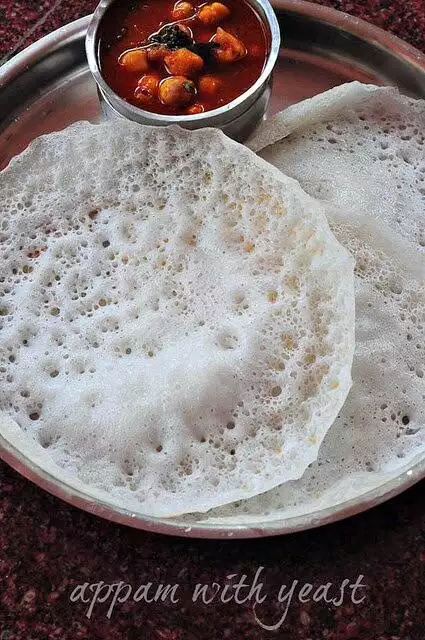
Kerala appam or aappam is a thing of beauty. It’s the perfect embodiment of what Kerala breakfast recipes are all about – rice flour, some fermenting, light on the stomach, easily digestible, and also, a bit time-consuming to prepare than pouring cereal into a bowl. I rarely make appam at home and so, the different variations of appam recipes you see in here including this appam recipe without yeast are all from my mom’s kitchen. Served with Kerala kadala curry or this Kerala egg roast, appam is quite a breakfast treat!
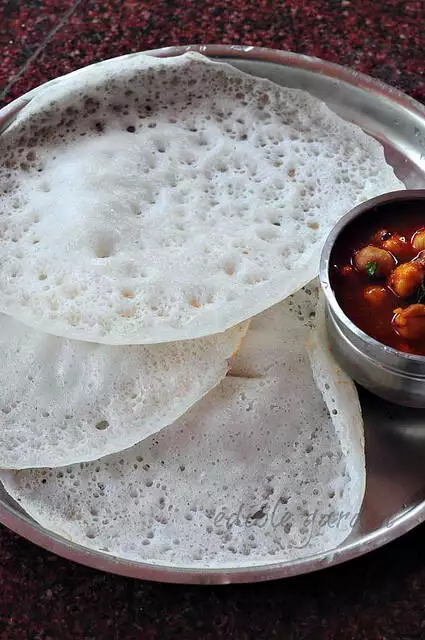
Preparing appam at home is not the easiest thing but the steps to make them are quite straight-forward. If you follow them systematically and also ensure optimum fermenting environment (this can be a challenge in colder places), then you will be rewarded with spongy, soft, lacy appams. I have resorted to instant appam powders for my appam needs many times and while it’s not exactly the real deal, it saves me from the occasional appam craving satisfactorily. There’s also a quick way to make appam from rice flour but that’s a recipe for another day.
You need coconut milk to make appam and it’s best if you make coconut milk at home, fresh. However, store-bought ones work as a decent substitute. Please don’t use the coconut milk powder though. The flavour of those things is way off, in my opinion.
You may also like to check out how to make dosa batter, how to make appam without yeast, easy idli batter recipe, and how to make poori.
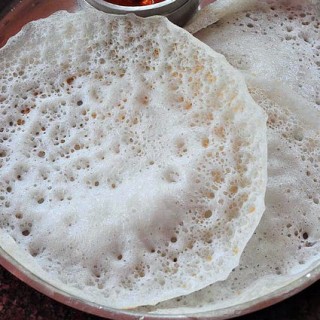
Kerala Appam Recipe
Ingredients
- 2 cups raw rice
- 3 cups grated coconut or 4 cups coconut milk
- 1/2 tsp instant yeast or 1 tsp active dry
- 2 tbsp sugar
- Salt to taste
Instructions
- Soak 2 cups of raw rice for 1-1.5 hours.
- In the meantime, prepare your coconut milk if you are making it fresh. Start with 3 cups of grated coconut and add enough water to extract 4 cups coconut milk from this.
- Reserve 1 cup coconut milk aside. Add the remaining to the soaked raw rice and grind to a smooth paste. You can use a wet grinder or a blender/food processor. If you feel the quantity of coconut milk is not enough to grind the rice, add required amount of water.
- Once the rice mixture is smooth, take 2 tablespoon of it and add to the reserved coconut milk + 1 more cup of water. Bring this mixture to boil and let it thicken into a paste. Let it cool down completely.
- Once that mixture is completely cooled, turn your blender/grinder back on and add it to the ground rice flour mixture along with 1/2 tsp instant yeast (1 tsp if using active dry or any other kind) and grind for another couple minutes.
- Transfer batter to a vessel and keep covered at room temperature (between 26C to 32C) for about 4 hours and then refrigerate until you need it.
- Before cooking the appam, add salt to taste and 2 tbsp sugar as soon as it’s out of the fridge. If the batter is too thick, add water to bring it to the right consistency and let it come to room temperature before use.
- Appam batter should be quite light so that when you use the swirling technique, the edges are light and crisp. If your batter is thicker, you get appam of more uniform thickness and sponginess. We like it somewhere in between, as can you see the pics above
- Remember to cook covered until the appam is cooked through and spongy. There’s no need to flip them. Keep flame medium-low at all times.
- It’s best to use up all the batter once you have added salt and sugar. If you keep the batter, it will ferment further and turn too sour after a point.
Step by Step Pictures to Make Appam:
1. Soak 2 cups of raw rice for 1-1.5 hours.
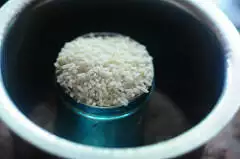
2. In the meantime, prepare your coconut milk if you are making it fresh. Start with 3 cups of grated coconut and add enough water to extract 4 cups coconut milk from this. There’s no need to separate out into first milk, second milk, etc. Check the coconut milk recipe post if you are unsure what I am talking about.
3. Reserve 1 cup coconut milk aside. Add the remaining to the soaked raw rice and grind to a smooth paste. You can use a wet grinder or a blender/food processor. If you feel the quantity of coconut milk is not enough to grind the rice, add required amount of water.
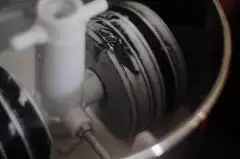
4. Once the rice mixture is smooth, take 2 tablespoon of it and add to the reserved coconut milk + 1 more cup of water. Bring this mixture to boil and let it thicken into a paste (sorry, I don’t have a picture of this!). Let it cool down completely.
5. Once that mixture is completely cooled, turn your blender/grinder back on and add it to the ground rice flour mixture along with 1/2 tsp instant yeast (1 tsp if using active dry or any other kind) and grind for another couple minutes.
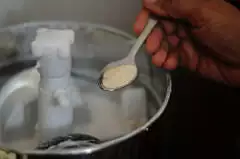
6. Transfer batter to a vessel and keep covered at room temperature (between 26C to 32C) for about 4 hours and then refrigerate until you need it.
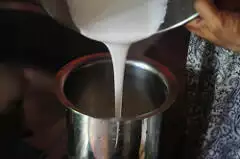
7. Before cooking the appam, add salt to taste and 2 tbsp sugar as soon as it’s out of the fridge. If the batter is too thick, add water to bring it to the right consistency and let it come to room temperature before use.
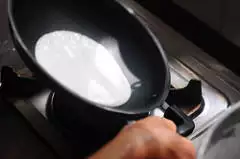
Appam batter should be quite light so that when you use the swirling technique, the edges are light and crisp. If your batter is thicker, you get appam of more uniform thickness and sponginess. We like it somewhere in between.
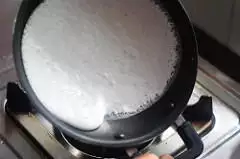
Check this video if you are unfamiliar with how to make appam in an appam pan or kadai with the swirling technique.
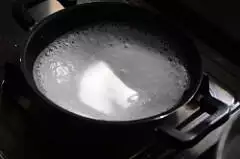
Remember to cook covered until the appam is cooked through and spongy. There’s no need to flip them. Keep flame medium-low at all times.
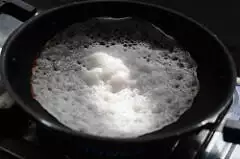
It’s best to use up all the batter once you have added salt and sugar. If you want to reserve some for later, add salt and sugar only to the amount of batter you require to use up immediately and refrigerate the rest. Serve with Kerala kadala curry for appam which is a spicy version with coriander and chillies, and sweetened coconut milk,. Delicious Kerala breakfast ready!

Finally the perfect appam recipe!! Lacy spongy airy appam! Totally worth the effort! Just a little sad that it won’t stay welL in the fridge! If I want to make a batter that can be refrigerated pls suggest what changes to make to the recipe?
I usually make appams with fermented coconut water and no yeast but this one so so perfect!
you can refrigerate this batter for 24 hours. i’ve tried it with good results!
Hi Nags,
Going to be making this over the weekend and I was just wondering (apologies in advance if the question is foolish) but if I am not making the coconut milk, is that 4 cups of commercially available coconut milk?
Thanks!
Niyati
yes! and you can dilute that a bit. maybe 3 cups coconut milk and 1 cup water
Hi Nags,
I tried the appam recipe and it came out wonderful. The only issue was when refrigerated for a day (even for few hours) the batter sedimented to the bottom and they was a clear liquid on top.
And when I tried making appam with this (after letting it come to room temperature) the appam came out rubbery and very less spongy than the unrefrigerated batter.
I’ve tried it three times with two different rice and it was the same, so no issues with my rice.
Kindly advice.
yes the batter can settle if left for a few hours. just mix well before preparing the appam. actually this batter doesn’t keep well, so you should make the appams and keep the cooked ones for later if you have leftover batter rather than storing the batter for longer.
Good resapi like
Thank you!
Dear your appam looks perfect.but I don’t like crispy edges..what to do to avoid crispy edges?
make appams on a flat griddle or tawa and shape thickly.
If using coconut do we have to grind along with rice for appam with yeast recipe.
Hello Geetha, If you want to add coconut to the batter, just add grated coconut directly to the batter before cooking the appam. Usually for this type of appam (called paalappam) we don’t add coconut to the batter. The regular appam made like dosa or oothappam is the one that has coconut in batter.